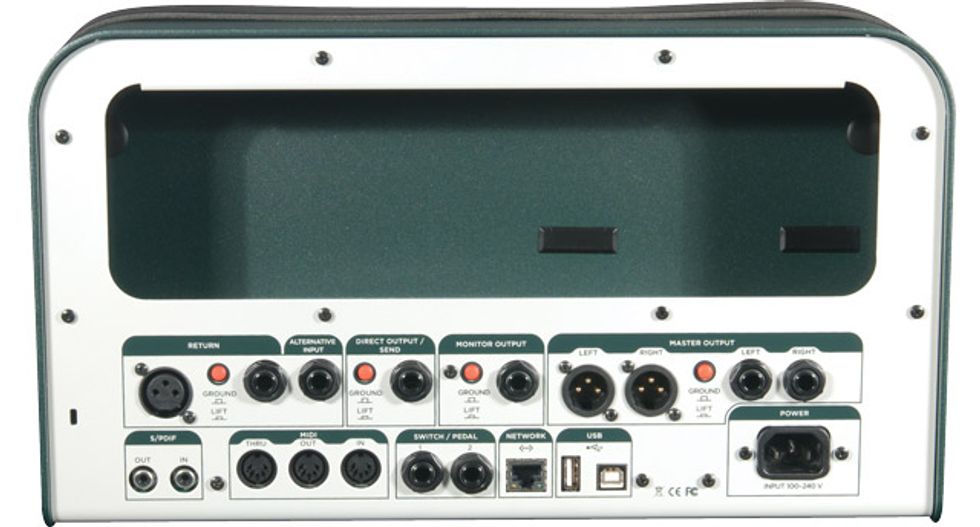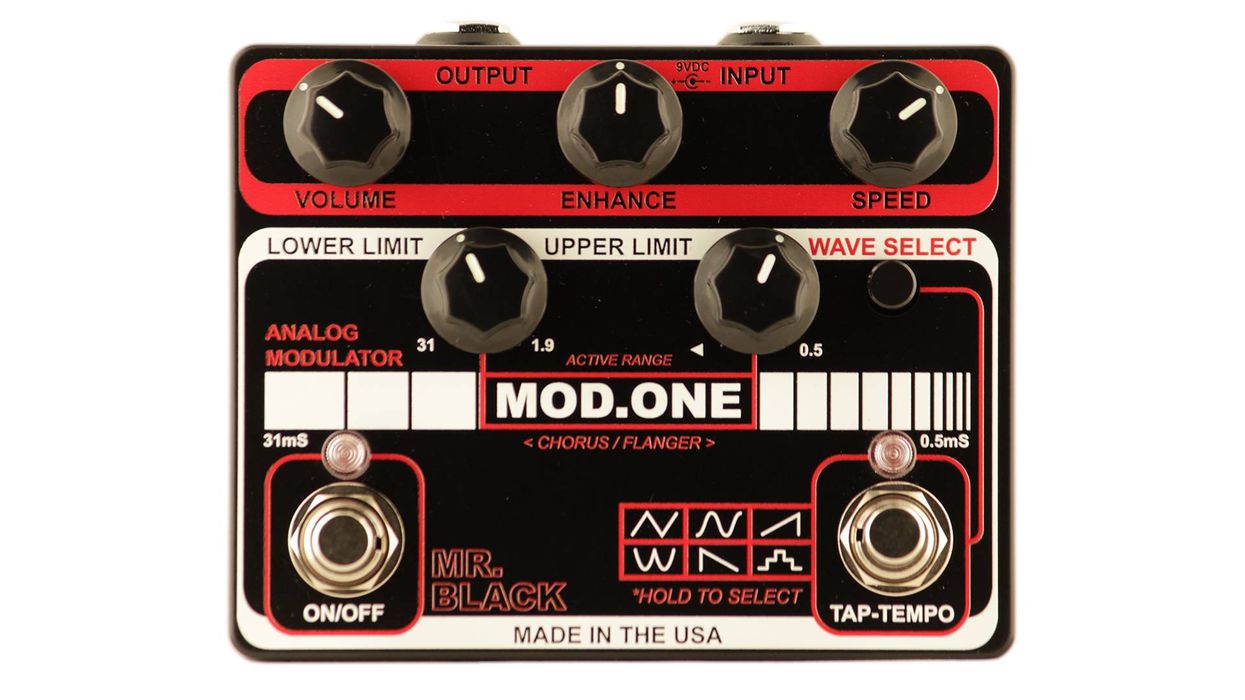When was the last time that someone tried to sell you an all-in-one amplifier? Was it at the start of the modeling craze in the early 2000s, or was it at the height of the solid-state amp boom when everybody was saying tubes were on their way out? Few would blame you if you tuned out the hype entirely at this point.
Kemper Amplification, however, has taken a very different approach to the challenge of delivering a multitude of amp tones in a single unit. Instead of designing a modeler that is loaded with preprogrammed emulations of the classics, the Kemper Profiling Amplifier lets you create your own models from real amps—the ones that best suit your own playing style.
Profilin’ and Stylin’
While the Profiling Amplifier looks like
it would be at home on a very advanced
alien spacecraft, the profiling process itself
is surprisingly simple. To set up a profile,
you warm up a tube amp (solid-state amps
work, too), plug a guitar into the Kemper’s
front input jack, and run an XLR cable
from the Kemper’s rear-mounted XLR jack
to a microphone set up to mic the source
amp’s speaker. Then, you complete a loop
by running a patch cable from the amplifier’s
input jack to the Kemper’s 1/4" direct
output/send jack. Through this loop, the
Kemper captures the tone DNA of the tube
amp. It’s sci-fi stuff, but it works.
The process is also surprisingly fast. You set the 5-way rotary chicken-head knob on the left side to the profiler setting, and the LCD screen gives you easy-to-follow instructions. You play through the amp you’re profiling and, using a pair of headphones, listen to how it sounds through the mic. Once you have an accurate sound picture of the amp, you start the profiling process. The Kemper sends out three pieces of garbled noise to the amp’s input that represent high-, middle- and low-frequency ranges. It sounds a little like a fax modem running through a Big Muff, but don’t worry—these signals are designed to evaluate how the amp’s circuitry and cabinet react to the input. The mic picks up the signals as they come out the other end of the amp circuits and cabinet, and then sends them back into the Kemper for processing—the end result, as strange as it seems, is a super-accurate profile of the amp’s unique dynamics and response to different frequencies and signals.
Once you create a basic profile of your amp, you can fine-tune it in the amplifier portion of the stack section (top middle of control panel). Here you can alter power amp sag, dial in vintage or modern response qualities, adjust the level of compression, and even how much pick attack comes through. The cabinet’s voicing and size can be changed, too.
You can also apply several fully adjustable effects, including distortion, phasing, EQ, and delay from the Kemper’s model banks, and place them in any order you desire. When you want to save the rig you’ve assembled, you simply press the store button, name the preset, and save it to the Kemper’s storage banks. When you want to call the profile back up, you flip the rotary switch to browse and scroll through the patches until you find what you’re looking for. Conveniently, Kemper ships the device with a ton of fully editable factory patches.
Since the Kemper is essentially a preamp, the device has a couple of options for amplification. For live use, you can run out of two XLR or two 1/4" outs to a PA mixer, or to a separate power amp running into a speaker cabinet (the amp’s cabinet emulation can be disabled for these situations). A dedicated monitor output and S/PDIF input and output jacks round out the audio connections, and a set of MIDI and 1/4" jacks for footswitching offer a wide range of control options. The back panel also sports an RJ-45 jack for network interfacing, along with two USB jacks for updating the firmware and uploading custom rigs from other Kemper Profiling Amp users.
Sadly, one of the amp’s coolest features, the perform function (which essentially allows you to compile up to five saved rigs in one patch, and switch between them either via MIDI or a footswitch when playing live) was not a working feature in the software at the time of this review. Kemper promises that the feature will be available as a firmware update in the future.

Hearing is Believing
The Kemper’s ability to quickly and painlessly
capture the essence and quality of
every amp that I threw at it never failed
to amaze. If the unit has a flaw, it’s that
a given amp profile relies on the quality
of the signal that you capture with the
microphone—which means you need
some audio engineering instincts and a
decent microphone. If you have nice condenser
mics, you’ll need phantom power
that the Kemper’s XLR jack doesn’t offer,
but in such a case you likely have nice
preamps providing power anyway.
Remarkably, such limitations have little effect on the quality of the Kemper’s ability to capture an amp’s essence. I rounded up a pretty diverse collection of amps for the Kemper to clone—an Xits Sadie combo, Mesa/Boogie Dual Rectifier, Verellen Meatsmoke, Fender ’65 Twin Reverb reissue, and a Vox AC30 combo.
With the Dual Rectifier running into an Emperor 4x12 loaded with Weber C1265 speakers, and a Les Paul Custom in hand, I used a Sennheiser e609 microphone to find the cab’s sweet spot and initiated the profiling process.
When I was finished, I was floored at how precisely the Kemper captured the Mesa’s complex tonality. The profile loosened and tightened in response to pick attack in the same manner as the actual amp, and cleaned up in a frighteningly similar fashion when I rolled down the guitar’s volume control. Even the Kemper’s onboard, 3-band EQ, presence, and gain controls affected the model in much the same way as the real Boogie would—especially with respect to how the gain control tends to tighten and soften the amp’s response.
Each of the remaining amps generated similarly accurate patches. The AC30 as captured by the Kemper delivered a big, robust midrange that bloomed as I opened up the gain, and displayed a knack for refined high end after I switched to a 2010 Fender American Strat.
Ratings
Pros:
Astonishing ability to create near dead-on reproductions
of tube amps. Excellent array of effects. Lightweight and
affordable.
Cons:
No phantom power. demands a good ear for proper
mic placement.
Tones:
Playability/Ease of Use:
Build:
Value:
Street:
$1,850
Kemper
kemper-amps.com
The sparkle and clarity of the Twin Reverb was captured flawlessly, and I was ecstatic that I was able to add a little something to the Twin formula that I’ve wanted for a while—a little power section sag at crisper settings. I felt as if I was effectively building my own custom amplifier at this point—pulling back the amp’s pick attack level and adding in a little more vintage response to warm things up a bit. Since I profiled the amp dry, I threw on a little reverb and a slight delay, which made the tone even more expansive. And the Kemper’s stompbox models also offered some very smooth-sounding reproductions of famous boost pedals—like the Ibanez TS-9 Tube Screamer—that juiced the front end nicely.
One amp that the Kemper had a tougher time nailing was the Xits Sadie, which has a unique clarity to it that I’ve rarely heard in an amp before.—it’s very, very pristine and honest. The Kemper did an admirable job of getting a good picture of the amp’s tone and response qualities, but fell a bit short on really attaining its glassiest highs.
Kemper didn’t really design the Profiling Amp to handle bass amps, but it’s definitely capable of doing this, and according to the company, bass profiling is completely safe. Even though the Kemper didn’t capture the huge subs that the Verellen Meatsmoke is capable of generating, it did get the tonality and response down eerily well, with plenty of low end for most types of bass work.
The Verdict
The Kemper Profiling Amp is one of those
pieces of gear that you have to check out,
regardless of how you feel about modeling,
digital circuitry, or anything else that dares
challenge the supremacy of the classics.
True, you need to profile a great amp to
get great tone. And there is a bit too much
room for human variables in the tone-capturing
process to guarantee the results.
On the other hand, this isn’t simply another modeler that makes promises that it really can’t keep. It’s capable of truly awe-inspiring results and it’s actually quite affordable for what it does—which is much, much more than what we can cover in this review. Perhaps the only real drawback will be the response you get from friends when you come over to profile their own classics—making you a new guitar-playing version of the guy that comes by to drink all your beer and rip all your CDs. But if you need tone by any means necessary, the Kemper Profiling Amplifier holds the key.









![Rig Rundown: Russian Circles’ Mike Sullivan [2025]](https://www.premierguitar.com/media-library/youtube.jpg?id=62303631&width=1245&height=700&quality=70&coordinates=0%2C0%2C0%2C0)


























